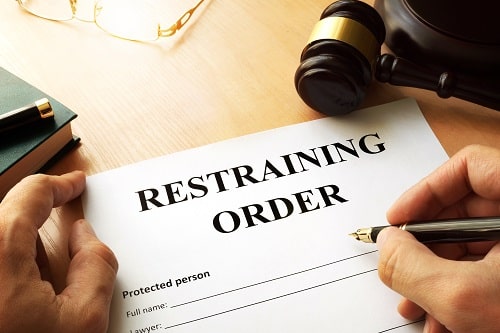Someone has asked for a domestic violence restraining order against you. A domestic violence restraining order is a court order that can help protect people who have been abused by someone they have been intimate with, or are closely related to.
Form DV-100: This form has all the orders that the person has asked the judge to order.
Form DV-109: Your court hearing (court date) is listed on this form. You should attend the court hearing if you do not agree to the orders requested. If you do not attend, the judge can make orders against you without hearing from you.
Form DV-110: If you were served with form DV-110, it means that the judge granted a temporary restraining order against you. You must follow the orders.
What Can a Restraining Order Do?
A restraining order can include orders for you to:
- Not contact or harm the protected person, including children or others listed as protected people
- Stay away from all protected people and places
- Not have any firearms (guns), firearm parts, or ammunition. This includes homemade or untraceable guns, like “ghost guns.”
- Move out of the place that you share with the protected person
- Follow custody and visitation orders
- Pay child support
- Pay spousal support
- Pay debt for property
- Give control of property (examples: cell phone, car, home) to the person asking for protection.
What If I Have Children With The Person Asking For a Restraining Order?
A restraining order can include orders for your children, including listing them as protected persons. It can also include child custody and visitation orders and orders to limit your ability to travel with your children.
How Long Does The Order Last?
If the judge granted a temporary restraining order (form DV-110), it will last until the hearing date. At your court hearing, the judge will decide whether to extend the order or cancel the order. The judge can extend the order for up to five years. Custody, visitation, child support, and spousal support orders can last longer than five years and they do not end when the restraining order ends.
What Do I Do Next?
If there is a temporary restraining order against you (see form DV-110), then you must immediately turn in, sell, or store any prohibited items you have or own. Prohibited items include:
- Firearms, including any handgun, rifle, shotgun, and assault weapon
- Firearm parts, meaning receivers, frames, and any item that may be used as or easily turned into a receiver or frame
- Ammunition, including bullets, shells, cartridges, and clips
You must then prove to the court that you’ve complied with the orders. Bring form DV-800/JV-270, Receipt for Firearms, Firearm Parts, and Ammunition, to a gun dealer or law enforcement when you turn in your items. After DV-800/JV-270 is complete, file it with the court.
How Do I Respond To a Domestic Violence Restraining Order?
First, it is important to understand that if you have been arrested for domestic violence, anything you saw or write during your family law domestic violence restraining order can be used against you during your criminal matter. It is therefore critical that you secure the advice of a criminal defense attorney prior to responding to the family law matter.
If it is appropriate in your case, you then prepare, serve, and file, a Response (form DV-120). “Respond” means to let the judge and the other side know whether you agree or disagree with the request for restraining order, and why. This is your opportunity to explain why the allegations against you are either false, misrepresented, or did not happen the way it is described in form DV-100. It is best to be as detailed as possible when explaining your version of events.
If you have allegations of domestic violence against the other side, it may be worthwhile to file your own Domestic Violence Restraining Order Request. The court can consider the mutuality of the allegations, but it must be separately plead.
What Happens at The Court Hearing?
At your court hearing, the judge will decide whether to grant the protected party a long-term restraining order that can last up to five years. It is important to bring any evidence or witnesses that you may have. If you are representing yourself, it may help to plan out and make notes about what you want to say to the judge. If needed, you can use your notes for your court hearing. Read over the court papers in your case and write out anything else you want the judge to know. Focus on the facts and details that support your side of the story. If you are represented by an attorney, your attorney will prepare for the hearing with you.





